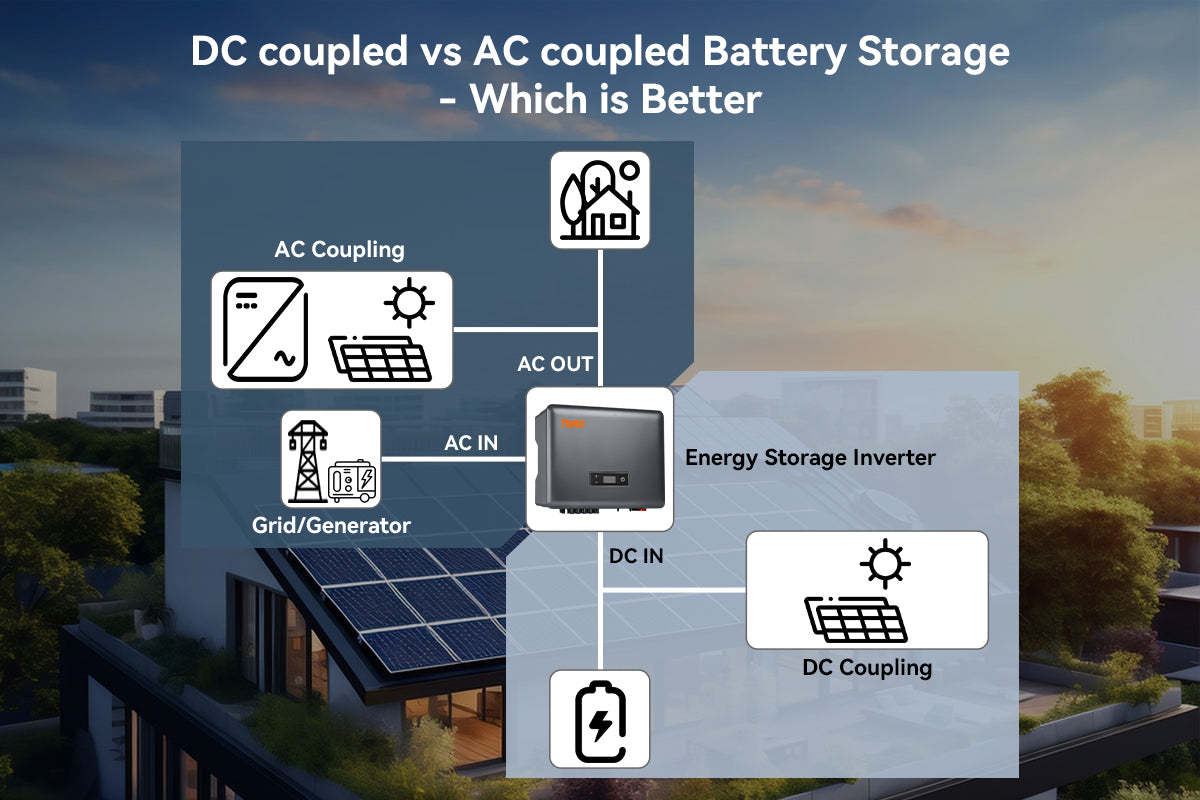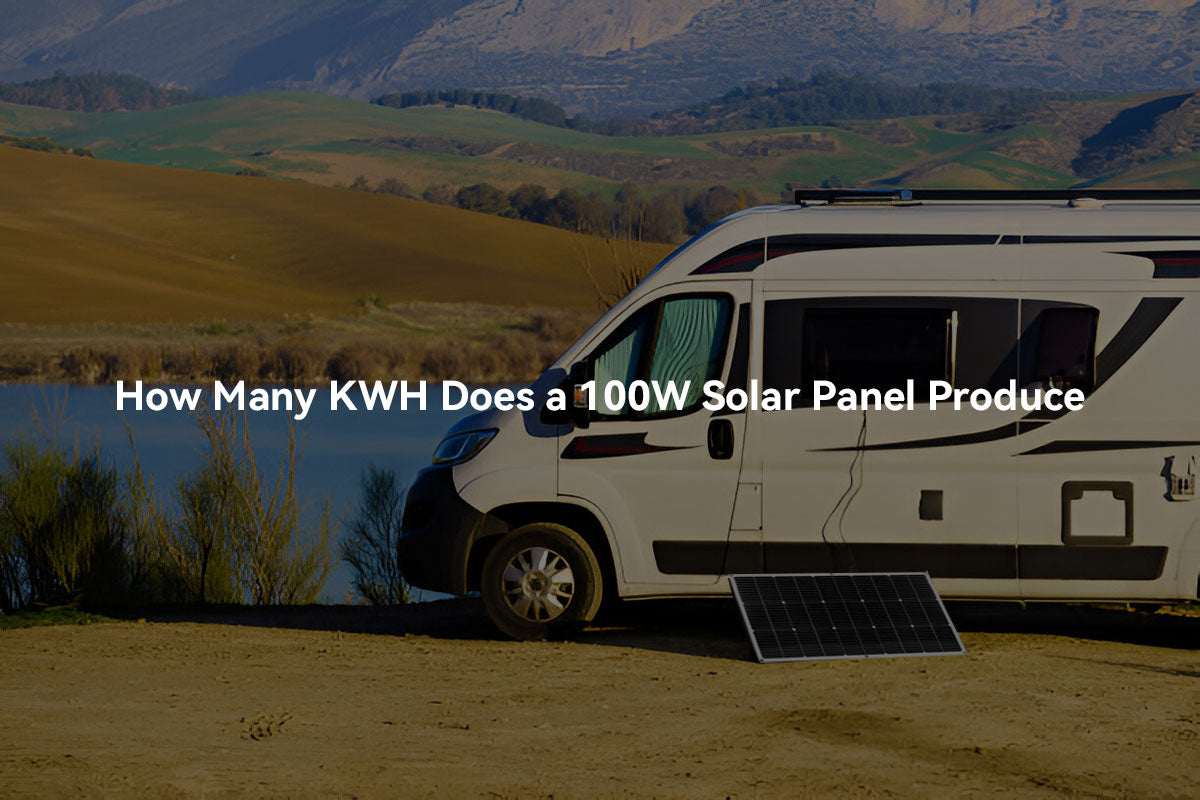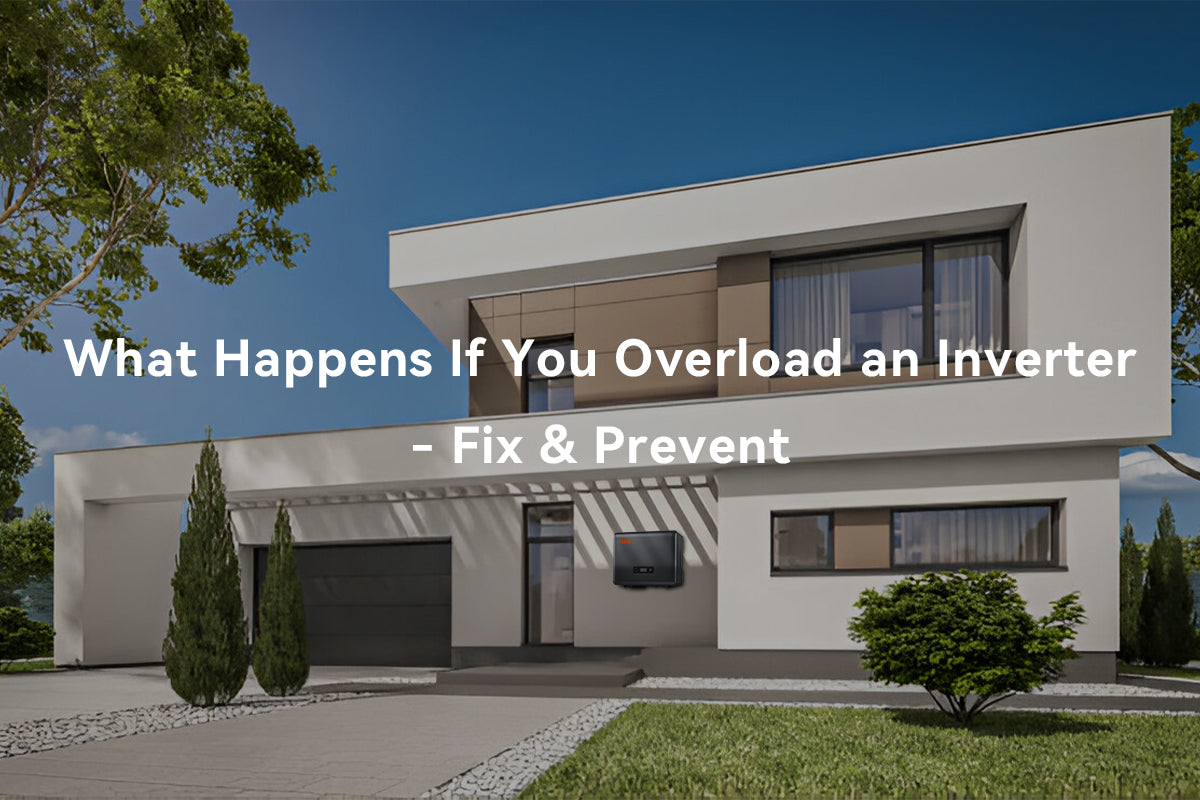ในยุคที่พลังงานแสงอาทิตย์กำลังปฏิวัติการใช้พลังงาน แบตเตอรี่พลังงานแสงอาทิตย์จึงมีความสำคัญต่อเจ้าของบ้านในการบรรลุเป้าหมาย electricity savings and uninterrupted power supply. As more people integrate batteries into their ระบบพลังงานแสงอาทิตย์, เดอะ การเลือกระหว่าง การเชื่อมต่อ AC และการเชื่อมต่อ DC เป็นสิ่งสำคัญสำหรับการเพิ่มประโยชน์จากพลังงานแสงอาทิตย์ พลังงาน.
ในบทความนี้ เราจะสำรวจความซับซ้อนของการเชื่อมต่อ DC และ AC ข้อดีและข้อเสียของพวกเขา และ วิธีการกำหนดตัวเลือกที่ดีที่สุดสำหรับระบบพลังงานแสงอาทิตย์ของคุณ.
DC Coupling คืออะไร
DC coupling refers to a method where the electrity from solar panels directly storage in the battery ระบบ ผ่านการชาร์จไฟ DC controller/an inverter สำหรับเก็บพลังงาน. ดีซี ไฟฟ้าที่ผลิตโดยแผงโซลาร์เซลล์จะชาร์จแบตเตอรี่ และ จากนั้นอินเวอร์เตอร์จะแปลงพลังงานไฟฟ้ากระแสตรงที่เก็บไว้เป็นไฟฟ้ากระแสสลับ (AC) สำหรับการใช้งานในบ้าน.

ตัวอย่างทั่วไปของระบบโซลาร์เซลล์แบบ DC-Coupled
ระบบ เก็บพลังงานจากพลังงานแสงอาทิตย์แบบใหม่ในที่อยู่อาศัย มักใช้การตั้งค่าที่เชื่อมต่อแบบ DC คลาสสิก ประกอบด้วยพลังงานแสงอาทิตย์ อินเวอร์เตอร์จัดเก็บและแบตเตอรี่ การออกแบบระบบรวมนี้ช่วยเพิ่มมูลค่าของการลงทุนเบื้องต้นให้สูงสุด อายุการใช้งาน ขอบคุณการจัดการพลังงานแบบสองทิศทาง ในหน่วยเดียว ผู้ใช้สามารถเพลิดเพลินกับความมากขึ้น ความสงบใจโดยไม่มี ความจำเป็นในการปรับปรุงในภายหลัง.
An off-grid solar ระบบ, ซึ่งมักใช้ในรถบ้านและบ้านขนาดเล็ก ทำงานได้อย่างอิสระจากกริด มันรวมถึง "ตัวควบคุมการชาร์จพลังงานแสงอาทิตย์และอินเวอร์เตอร์แบตเตอรี่หรืออินเวอร์เตอร์-ชาร์จเจอร์แบบรวม การเชื่อมต่อแบบ DC จะทำให้แน่ใจว่า" การจัดการพลังงานอย่างมีประสิทธิภาพโดยการจ่ายโหลดที่สำคัญโดยตรงจากแบตเตอรี่ในช่วงเวลาที่มีแสงอาทิตย์น้อย การผลิตหรือจัดหาพลังงานฉุกเฉินในช่วงที่มีการหยุดชะงักของกริด.
For users with an existing grid-tie solar ระบบ, การปรับปรุง การเชื่อมต่อกับการตั้งค่าที่เชื่อมต่อแบบ DC เป็นไปได้ โดยการเพิ่มพลังงานแสงอาทิตย์ การควบคุมการชาร์จและแบตเตอรี่ การจัดการพลังงานดีขึ้นอย่างมาก การตั้งค่านี้ต้องการแผงโซลาร์เซลล์แยกกันสองชุด อาร์เรย์: หนึ่งสำหรับการชาร์จแบตเตอรี่และอีกหนึ่งสำหรับการจ่ายไฟเข้าระบบ นอกจากนี้ยังมี มิเตอร์อัจฉริยะเพิ่มเติม จำเป็นที่จะต้อง ติดตามและจัดการการกระจายพลังงานระหว่างแบตเตอรี่, PV, และกริด.
ข้อดีของการเชื่อมต่อแบบ DC
ลดการสูญเสียพลังงาน
ในระบบที่เชื่อมต่อด้วยกระแสตรง กระแสไฟฟ้ากระแสตรง (DC) ที่สร้างขึ้นโดยแผงโซลาร์เซลล์จะไหลไปยังตัวควบคุมการชาร์จโซลาร์หรือ อินเวอร์เตอร์ไฮบริด ชาร์จแบตเตอรี่โดยตรง กระบวนการนี้ช่วยขจัดความจำเป็นในการแปลงไฟฟ้าจากพลังงานแสงอาทิตย์ จากกระแสตรง (DC) ไปเป็นกระแสสลับ (AC) และกลับไปเป็นกระแสตรง (DC) ก่อนที่จะเก็บไว้ในแบตเตอรี่ ซึ่งช่วยลดการสูญเสียพลังงาน.
ความสามารถในการซื้อ
สำหรับระบบจัดเก็บพลังงานแสงอาทิตย์ใหม่ ระบบที่เชื่อมต่อแบบ DC มีความคุ้มค่าทางเศรษฐกิจมากกว่า นอกจากพลังงานที่สูงขึ้น ประสิทธิภาพการแปลง, การรวมแบตเตอรี่และแผงไว้ภายใต้ตัวแปลงสัญญาณเดียวกันช่วยลดต้นทุนฮาร์ดแวร์ ทำให้สิ่งเหล่านี้ ระบบที่มีราคาไม่แพงมากขึ้น.
เพิ่มพลัง
ระบบที่เชื่อมต่อแบบ DC ช่วยให้สามารถเพิ่มแผงโซลาร์เซลล์เพิ่มเติมเพื่อสร้างพลังงานมากขึ้น ซึ่งสามารถนำไปใช้ได้ เปลี่ยนเส้นทางไปชาร์จแบตเตอรี่สำรอง, เครื่องชาร์จ EV, หรือระบบทำความร้อนน้ำ ในทางตรงกันข้าม ระบบที่เชื่อมต่อด้วย AC คือ จำกัดขนาดของระบบแผงโซลาร์เซลล์เนื่องจากความสามารถในการรับพลังงานจากแผงโซลาร์เซลล์ของอินเวอร์เตอร์เดิม.
ข้อเสียของการเชื่อมต่อ DC
ความยืดหยุ่นจำกัด
ในระบบที่เชื่อมต่อแบบ DC-coupled ตัวควบคุม แบตเตอรี่ และอินเวอร์เตอร์จะเชื่อมต่อกันแบบอนุกรม ซึ่งลดความยืดหยุ่น สำหรับใหม่ ระบบโฟโตโวลตาอิกแบบออฟกริด จำเป็นต้องออกแบบแผงโซลาร์เซลล์ แบตเตอรี่ และอินเวอร์เตอร์ตาม โหลดพลังงานและการใช้ไฟฟ้าของผู้ใช้ ในระบบที่ติดตั้งใหม่แบบ DC-coupled แบตเตอรี่จำเป็นต้องถูกวางไว้ ใกล้กับอินเวอร์เตอร์ ซึ่งอาจจำกัดตัวเลือกในการติดตั้ง.
AC Coupling คืออะไร
ระบบที่เชื่อมต่อด้วย AC ประกอบด้วยระบบพลังงานโซลาร์เซลล์ (PV) และระบบพลังงานแบตเตอรี่ ระบบ PV ประกอบด้วย แผงเซลล์แสงอาทิตย์และอินเวอร์เตอร์ที่เชื่อมต่อกับกริด ไฟฟ้ากระแสตรงที่ผลิตโดยโมดูล PV คือ แปลงเป็นไฟฟ้ากระแสสลับ ไฟฟ้าจากอินเวอร์เตอร์ ซึ่งสามารถนำไปใช้จ่ายพลังงานให้กับโหลดโดยตรงหรือส่งเข้าระบบไฟฟ้าได้ แบตเตอรี่ ระบบประกอบด้วยชุดแบตเตอรี่และอินเวอร์เตอร์เก็บพลังงาน ซึ่งชาร์จแบตเตอรี่ด้วยแหล่งพลังงาน จากอินเวอร์เตอร์ที่เชื่อมต่อกับกริดหรือจากกริด.

ตัวอย่างทั่วไปของระบบ AC-Coupled
การปรับปรุงสำหรับระบบ PV ที่มีอยู่:สำหรับระบบที่เชื่อมต่อกับกริดที่ต้องการการจัดเก็บแบตเตอรี่เพิ่มเติม ความจุ, การเชื่อมต่อ AC คือ ใช้บ่อย. แบตเตอรี่สามารถเชื่อมต่อกับด้านเอาท์พุต AC ได้อย่างง่ายดาย เช่นเดียวกับกริด.
บริการกริด: ผ่านการเชื่อมต่อ AC, พลังงานแสงอาทิตย์และสินทรัพย์แบตเตอรี่สามารถทำงานได้อย่างอิสระและสามารถกำหนดขนาดได้ แยกกัน. นี้ ทำให้ปรับแต่งระบบสำหรับการใช้งานในกริดได้ง่ายขึ้น เช่น การควบคุมความถี่.
การปรับปรุงเชิงพาณิชย์: เพื่อหลีกเลี่ยงการเดินสายไฟใหม่อย่างกว้างขวางในระบบไฟฟ้าเก่า อาคารพาณิชย์ ที่มีขนาดใหญ่ ความต้องการจัดเก็บพลังงานมักเลือกการเชื่อมต่อ AC เมื่อเพิ่มระบบพลังงานแสงอาทิตย์และการจัดเก็บ
ข้อดีของการเชื่อมต่อ AC
การติดตั้งที่ง่ายขึ้น
ในระบบที่เชื่อมต่อด้วย AC อินเวอร์เตอร์ที่เชื่อมต่อกับกริด แบตเตอรี่ และตัวแปลงสองทิศทางจะเชื่อมต่อกันแบบขนาน. การเพิ่มระบบจัดเก็บข้อมูลให้กับระบบโฟโตโวลตาอิกที่มีอยู่แล้วนั้นเพียงแค่ต้องติดตั้งแบตเตอรี่และระบบสองทิศทาง ตัวแปลง โดยไม่กระทบต่อระบบ PV ดั้งเดิม.
ความยืดหยุ่น
ผู้ติดตั้งสามารถวางอินเวอร์เตอร์และแบตเตอรี่ได้อย่างอิสระ ทำให้สามารถปรับเปลี่ยนการตั้งค่าได้ เมื่อเพิ่มระบบจัดเก็บข้อมูลไปยัง ระบบ PV ที่มีอยู่สามารถรวมเข้ากับระบบได้โดยตรงโดยไม่ต้องปรับการออกแบบระบบเพิ่มเติม การจัดเก็บ การออกแบบระบบเป็นอิสระจากระบบ PV และสามารถปรับให้เหมาะกับความต้องการเฉพาะได้.
ข้อเสียของการเชื่อมต่อ AC
การแลกเปลี่ยนประสิทธิภาพ
ในระบบที่เชื่อมต่อด้วย AC ไฟฟ้าจากแผงโซลาร์เซลล์จะถูกแปลงเป็น AC โดยอินเวอร์เตอร์เชื่อมต่อกับกริดก่อน จากนั้นจะถูกเก็บไว้ในแบตเตอรี่ผ่านตัวควบคุม/อินเวอร์เตอร์เก็บพลังงาน สุดท้ายมันจะจ่ายพลังงานให้กับโหลดหลังจาก DC อีกครั้ง การแปลงเป็น AC ส่งผลให้มีการแปลงระหว่าง DC และ AC สามครั้ง ซึ่งนำไปสูการสูญเสียประสิทธิภาพ.
หยุดการผลิตไฟฟ้า
ถ้าหากเกิดการขัดข้องและมีการดึงพลังงานจากแบตเตอรี่มากเกินไป อินเวอร์เตอร์ที่เชื่อมต่อกับกริดจะปิดตัวลง ทำให้แผงโซลาร์เซลล์หยุดผลิตพลังงาน เจ้าของระบบอาจต้องรอให้ไฟฟ้าจากกริดกลับมา ก่อนที่ระบบจะกลับมาออนไลน์และชาร์จแบตเตอรี่ได้
การเชื่อมต่อแบบ DC กับการเชื่อมต่อแบบ AC: แบบไหนดีที่สุดสำหรับระบบพลังงานแสงอาทิตย์ของคุณ?
เมื่อใดควรเลือกการเชื่อมต่อแบบ DC
ถ้าคุณ ใช้ไฟฟ้ามากขึ้นในตอนกลางคืน มากกว่าตอนกลางวัน การเชื่อมต่อแบบ DC จะเหมาะสมกับคุณมากกว่า. ในระหว่างวัน กระแสตรง (DC) ที่ผลิตโดยแผงโซลาร์เซลล์จะถูกเก็บไว้ในแบตเตอรี่โดยตรงผ่านตัวควบคุม การบรรลุประสิทธิภาพมากกว่า 95% ในทางตรงกันข้าม การเชื่อมต่อแบบ AC เกี่ยวข้องกับการแปลงกระแสตรงจากแผงโซลาร์เซลล์เป็น กระแสสลับ (AC) โดยใช้เครื่องแปลงสัญญาณ จากนั้นกลับเป็นกระแสตรง (DC) ผ่านเครื่องแปลงสัญญาณแบบสองทิศทางก่อนที่จะเก็บไว้ใน แบตเตอรี่ กระบวนการนี้ทำให้ประสิทธิภาพลดลงเหลือประมาณ 90% หรือน้อยกว่า.
สำหรับ การติดตั้งโซลาร์เซลล์ใหม่ ระบบที่เชื่อมต่อด้วย DC เป็นตัวเลือกที่ต้องการมากกว่า พวกเขามีความ คุ้มค่าในแง่ของ ทั้งอุปกรณ์และการติดตั้งเมื่อเปรียบเทียบกับระบบที่เชื่อมต่อด้วย AC ระบบที่เชื่อมต่อด้วย AC จะรวมถึงอินเวอร์เตอร์ที่เชื่อมต่อกับกริด อินเวอร์เตอร์แบบสองทิศทาง และแผงจ่ายไฟ ซึ่งมีต้นทุนการผลิตและติดตั้งสูงกว่าที่ ตัวควบคุมหรืออินเวอร์เตอร์เก็บพลังงานที่ใช้ในระบบที่เชื่อมต่อแบบ DC ตัวควบคุมและสวิตช์ถ่ายโอนคือ อย่างมีนัยสำคัญ ถูกกว่าตัวแปลงไฟฟ้าแบบเชื่อมต่อกริดและแผงจ่ายไฟ.
เมื่อใดควรเลือกการเชื่อมต่อแบบ AC
ถ้าคุณใช้ไฟฟ้ามากขึ้นในระหว่างวัน ระบบที่เชื่อมต่อกับแอร์จะเหมาะสมกว่า ไฟฟ้าจากแผงโซลาร์เซลล์คือ แปลงโดยตรงโดยอินเวอร์เตอร์เพื่อจ่ายโหลด โดยมีประสิทธิภาพมากกว่า 96%.
สำหรับระบบโซลาร์เซลล์ที่เชื่อมต่อกับกริดที่มีอยู่ เราขอแนะนำให้เลือกการเชื่อมต่อแบบ AC ซึ่งต้องการเพียงแค่การเพิ่มแบตเตอรี่และ อินเวอร์เตอร์แบบสองทิศทางเข้าสู่ระบบ โดยไม่มีผลกระทบต่อการติดตั้งโซลาร์เซลล์เดิม การเพิ่มระบบที่เชื่อมต่อด้วย DC จะ มีค่าใช้จ่ายมากขึ้น เนื่องจากจะต้องมีการออกแบบระบบพลังงานแสงอาทิตย์ใหม่ทั้งหมด.
บันทึก:
โปรดใส่ใจ ข้อจำกัดด้านกฎระเบียบท้องถิ่นเกี่ยวกับขนาดของอินเวอร์เตอร์ที่อนุญาต เพื่อ เชื่อมต่อกับ กริด ในบางพื้นที่มีการจำกัดความจุของอินเวอร์เตอร์ต่อเฟส และความจุรวมของอินเวอร์เตอร์ รวมถึงอินเวอร์เตอร์แบตเตอรี่ใด ๆ ในกรณีนี้ให้พิจารณาเปลี่ยนอินเวอร์เตอร์ที่มีอยู่ด้วยอินเวอร์เตอร์ที่เหมาะสม อินเวอร์เตอร์เก็บพลังงานไฮบริดขนาด
เลือกตามความต้องการเฉพาะของคุณ สรุปแล้ว ระบบที่เชื่อมต่อแบบ DC มีต้นทุนเริ่มต้นที่ต่ำกว่า ประสิทธิภาพที่สูงกว่า และจัดการได้ง่ายกว่า ในขณะที่ระบบที่เชื่อมต่อด้วย AC มีต้นทุนการปรับปรุงที่ต่ำกว่าและมีผลกระทบน้อยต่อระบบที่มีอยู่



